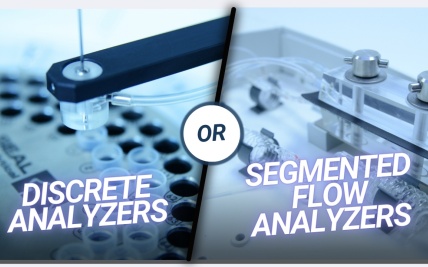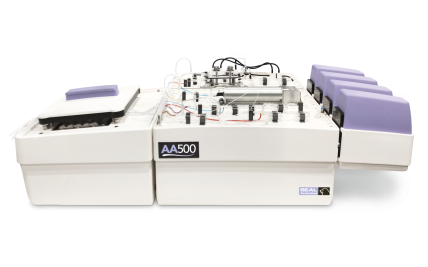Vorteile der Segmented Flow Analysis (SFA) gegenüber Flow Injection Analysis (FIA)
(1).jpg?resolution=1105x622&quality=95)
There are two kinds of continuous flow analysis:
| Segmented Flow Analysis (SFA): The reaction stream is segmented with bubbles of air or nitrogen, creating “Bolus Flow” and reducing inter-sample dispersion. |  |
| Flow Injection Analysis (FIA): There are no air bubbles in the reaction stream, creating “Laminar Flow”. The dispersion in the system is used to mix the samples and reagents. |  |
SEAL Analytical continuous flow analyzers use SFA technology because the addition of segmentation brings important advantages to routine analysis, including:
- Maximum sensitivity
- Reactions analyzed at completion
- No interference from micro bubbles
- Easy visual check of system operation and fluidics
- Low detection limits
- Stable and robust analytical methods
- Automation of complex procedures and sample pre-treatment
- Removal of interferences from dirty samples
1. Maximum Sensitivity
Two factors contribute to sensitivity:
- Complete reaction between reagents and sample
- Measuring the final reaction mixture at maximum concentration
Achieving a complete reaction:
If a time delay is necessary, the reaction stream can be delayed or heated. Because SFA can automate longer, hotter reactions, it allows slow reactions to proceed to completion as shown in the diagram.
| SFA | FIA | |
| Max. possible reaction time | 20 minutes | 1 minute |
| Max. possible reaction temperature | 95 °C | 60 °C |
Advantages of a complete reaction include:
- Sensitivity is brought to its maximum potential
- Small variations in reaction conditions such as changes in flow rate or temperature do not affect method sensitivity
- When the method sensitivity remains constant, results stay within specification for longer and recalibration is necessary less often

2. Reaction Analyzed at Completion
The sample concentration in the detector reaches a constant, maximum value (Steady State)
The output from a SFA system is a peak with a flat plateau. The plateau represents a constant, steady state value in the flowcell, at maximum concentration. The sample result is calculated from the peak height, which is averaged from readings on the plateau. In contrast, the sample peak from a FIA system only reaches maximum concentration for an instant.
The Steady State peaks of segmented flow analysis maximize sensitivity in two ways:
- The sample concentration in the flowcell reaches its maximum value, undiluted by wash or carrier solution.
- Maximum concentration is maintained for long enough to obtain an accurate reading.
 | Detector signal from a sample measured for a long time. Between t1 and t2 the concentration in the flowcell is constant. |
 | Sample peak from a normal SFA analysis. The sampling time is long enough to allow several seconds of steady state at maximum concentration. |
 | Sample peak from normal FIA (flow injection) analysis. |
3. No Interference from Micro Bubbles
Degassing from samples or reagents can introduce unwanted air bubbles into the reaction stream.
Whereas SFA systems are designed to work with bubbles in the reaction stream, air bubbles interfere with FIA in two ways:
- The pressure inside a FIA system is high, because 2-4 ml/min are pumped through tubing 0.8-1 mm internal diameter. Compression of the air bubble disrupts the regular flow which is necessary for reproducible results.
- As shown in the figures below, an air spike is easily separated from the height measurement of a SFA peak’s flat plateau, but cannot be easily removed from a FIA peak, whether the area or height is measured.
 | SFA peak with interference from an air bubble in a reagent. The spike is eliminated from the average reading for the peak plateau and does not affect the result. |
 |


.jpg?resolution=428x267&quality=95)
